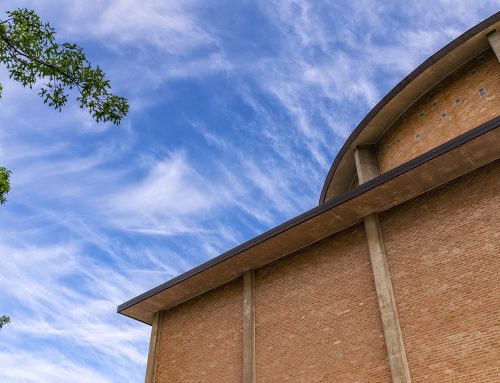One of the most architecturally significant homes on Strait Lane is included in a new biography about its architect, Philip Johnson, by Dallas Morning News architecture critic Mark Lamster.
“The Beck House is the one that’s modern, whereas most of the ones around there are fake French chateaux or fake colonial mansions,” Lamster says about the homes on Strait Lane, which he calls “the Fifth Avenue of Preston Hollow.” “It is the effigy of opulence. It’s so Dallas, and it’s perfect. It’s beautifully made, and it’s a wonderful space to be in.”
The home at 10210 Strait Lane comprises 14,387 square feet, six bedrooms, seven full baths and four partial baths. A grand double staircase inside resembles one in a museum. The house and the 6.45-acre lot is now owned by Naomi Aberly and Larry Lebowitz and is on the market for $23 million, according to Sotheby’s International Reality. The building, which was the site of two fundraisers for former President Barack Obama, was recently restored by architects Bodron+Fruit and the landscape by the Massachusetts firm of Reed Hilderbrand.
Johnson built the house in 1964 for Henry and Patty Beck, according to Lamster, the author of “The Man in the Glass House: Philip Johnson, Architect of the Modern Century,” which Smithsonian magazine called one of the best history books of 2018. Since the couple owned the Beck Construction Co., the house was a showpiece for what the company could do. When the Becks were disappointed with their original architect, they called in Johnson. He wrapped the house in a two-story, bright-white concrete arcade.
“It is the effigy of opulence. It’s so Dallas, and it’s perfect. It’s beautifully made, and it’s a wonderful space to be in.”
“The concrete looks like marble because it’s so pristine,” Lamster says. “It was actually manufactured by aeronautical fabricators because it had to be so perfect. All those concrete edges are completely sharp.”
 Johnson, who died at 98 in 2015, was the first recipient of the Pritzker Prize and MoMA’s founding architectural curator. Lamster, a professor at the University of Texas at Arlington School of Architecture, says Johnson virtually invented the term “starchitect,” the celebrity architect. “Johnson was a historicist who championed the new, an elitist who was a populist, a genius who lacked originality, a gossip who was an intellectual, a nihilist who was a utopian, a man of endless generosity who could be casually, crushingly cruel,” Lamster wrote in an October newspaper article.
Johnson, who died at 98 in 2015, was the first recipient of the Pritzker Prize and MoMA’s founding architectural curator. Lamster, a professor at the University of Texas at Arlington School of Architecture, says Johnson virtually invented the term “starchitect,” the celebrity architect. “Johnson was a historicist who championed the new, an elitist who was a populist, a genius who lacked originality, a gossip who was an intellectual, a nihilist who was a utopian, a man of endless generosity who could be casually, crushingly cruel,” Lamster wrote in an October newspaper article.
The Beck House’s architecture style wasn’t critically fashionable when it was created. “It didn’t really have a name at the time,” Lamster says. “Now people are calling it ‘the new formalism.’ It’s a reaction against modernism, that sort of dogmatic modernism of glass and steel that Johnson had been a practitioner of. Not only is it objectionable aesthetically, but it seems like this moral failing of him personally, that he would go back on his modernist ideals. You can read it in that house.”
Wrote The New York Times in 2010, “There’s something almost campy about the Beck House’s grand proportions and the relentlessness of its arches, but the arches are impressive from without and frame romantic views of the house’s six-and-a-half-acre site from within.”
How Philip Johnson found his way to Preston Hollow:
• Johnson met Houston’s John and Dominique de Menil, French émigrés. A French baron, John married Dominique, whose family owned the Schlumberger oil services empire. Both were involved with the Museum of Modern Art in New York, where they met Philip Johnson, who was a curator and on the board there. He designed a house in Houston, the University of St. Thomas and other projects for the Menils. “They were the conduits for him to get a toehold in Texas,” Mark Lamster, architecture critic of The Dallas Morning News, says.
• Through the Menils, Johnson landed a series of commissions in Texas with the Carter family. He built the Amon Carter Museum in Fort Worth and the Fort Worth Water Gardens.
• Later, Johnson connected with Gerald Hines, the Houston developer. Hines became the chief client for his skyscrapers and built several of his best.
• In Dallas, in addition to the Beck House, Johnson designed the John F. Kennedy Memorial, Momentum Place (now the Comerica Tower, Dallas’ tallest skyscraper), Cathedral of Hope/Interfaith Peace Chapel, Thanks-Giving Square Complex and The Crescent.
• “Beck said, ‘I get paid very well to be a whore, and I have no principles,’ ’’ Lamster says. “The Crescent is a good example of his whorishness.”






